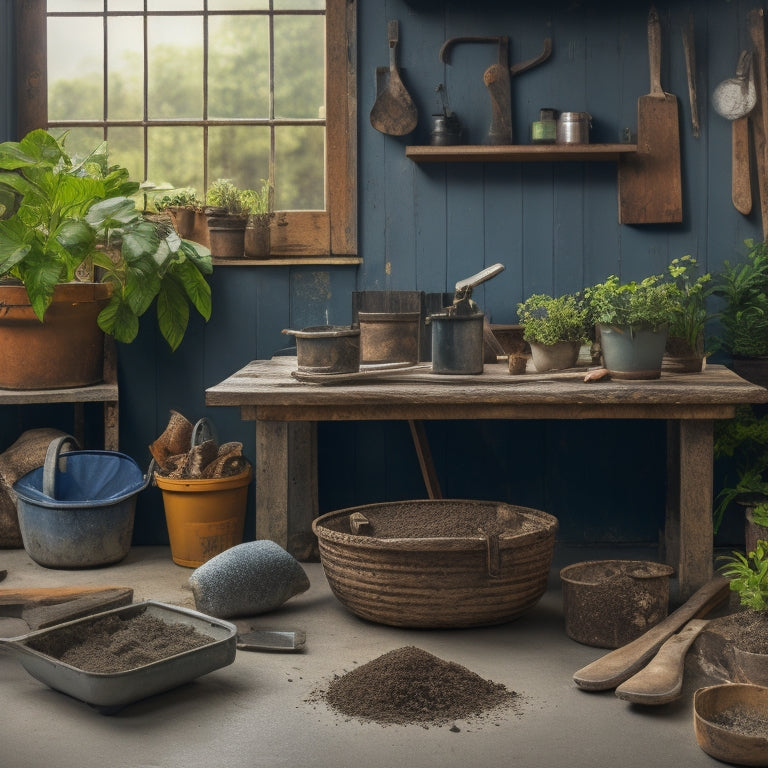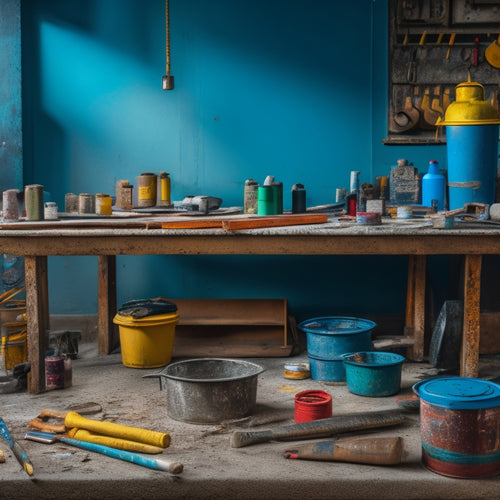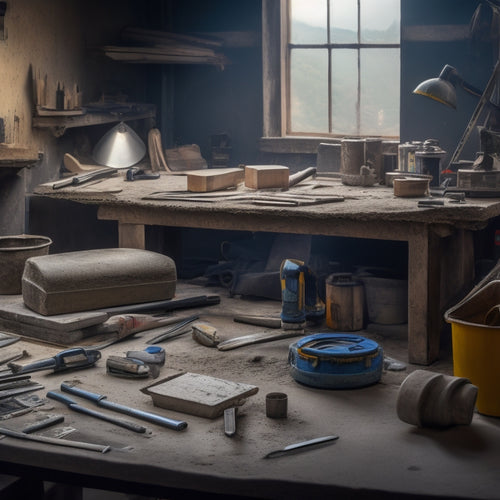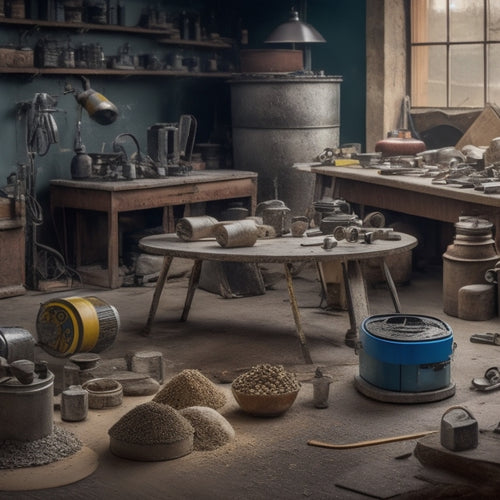
What Tools Do I Need for Concrete Planters
Share
You'll need a range of essential tools and equipment to create durable and visually appealing concrete planters. Start with personal protective gear like gloves, safety glasses, and dust masks, as well as basic hand tools like trowels, edgers, and hammers. Power tools like angle grinders, rotary hammers, and disc sanders will help with shaping, while mixing and measuring equipment like digital scales and mixing buckets guarantee accurate concrete ratios. Additionally, you'll need waterproofing and sealing tools, painting and finishing essentials, and reinforcement materials like steel mesh and fiber additives. As you immerse yourself in the world of concrete planters, you'll discover these tools are just the beginning of your creative journey.
Key Takeaways
• Essential safety gear, including PPE, eye protection, hearing protection, dust masks, and gloves, is required for concrete planter projects.
• Basic hand tools like trowels, edgers, jointers, scrapers, and hammers are necessary for shaping and finishing concrete planters.
• Power tools such as angle grinders, rotary hammers, and disc sanders are used for shaping and smoothing concrete surfaces.
• Mixing and measuring equipment, including digital scales, mixing buckets, and mixing trowels, ensure accurate concrete mixture ratios.
• Waterproofing and sealing tools, like concrete sealers, application tools, and surface preparation tools, are crucial for creating a watertight barrier against moisture.
Essential Safety Gear Required
You'll need to wear essential personal protective equipment (PPE) like gloves, safety glasses, and a dust mask when working with concrete to prevent skin irritation, eye damage, and respiratory problems.
Safety goggles will shield your eyes from flying debris and concrete particles, while ear protection will safeguard your hearing from the loud mixing and drilling sounds. Don't underestimate the importance of a dust mask, as it will filter out hazardous particles, preventing respiratory issues.
A good pair of gloves will provide grip, protection, and dexterity, allowing you to handle tools and materials with confidence. Look for gloves with a textured palm and fingers to guarantee a firm grasp on slippery surfaces. Additionally, consider gloves with reinforced fingertips for added protection.
Basic Hand Tools Needed
Five essential hand tools - a trowel, edger, jointer, scraper, and hammer - will become your go-to companions when crafting concrete planters. These basic hand tools are must-haves for any concrete planter project.
With them, you'll be able to shape, smooth, and finish your planters with ease. Start by using your trowel to apply and smooth out the concrete mixture. The edger will help you create clean, defined edges, while the jointer will allow you to fill in any gaps or cracks. Your scraper will come in handy for removing excess concrete, and your hammer will provide the necessary force for shaping and tapping pieces into place.
To guarantee your tools remain in top condition, prioritize tool maintenance. Regularly clean and store your tools to prevent rust and damage. This will ensure your tools remain reliable and efficient, allowing you to focus on perfecting your concrete planter craft.
Power Tools for Shaping
As you move on to shaping your concrete planters, you'll need to harness the power of specialized tools to achieve the desired forms and textures.
You'll be working with high-speed cutting and grinding tools, so it's crucial to understand their capabilities and limitations to get the best results.
From angle grinders to rotary hammers and disc sanders, mastering these power tools will help you bring your design vision to life.
Angle Grinder Uses
What makes an angle grinder an indispensable tool for shaping concrete planters is its ability to aggressively remove excess material and smooth out rough edges with precision. When you're working with concrete, you need a tool that can handle the tough stuff, and an angle grinder delivers. With its powerful motor and rotating disc, you can make quick work of rough edges, bumps, and imperfections.
However, to get the most out of your angle grinder, you need to prioritize maintenance and safety. Regularly clean and inspect your grinder to prevent dust buildup and maintain proper function. Always wear protective gear, including gloves, safety glasses, and a dust mask, to prevent injury.
Additionally, make sure you're using the correct disc for the job – a diamond blade for concrete, for example – and keep the grinder well-lubricated to prevent overheating. By following these guidelines, you'll be able to tackle even the toughest concrete shaping tasks with confidence and control.
Rotary Hammer Tips
When tackling thick, hard concrete, a rotary hammer becomes an important power tool for shaping, allowing you to efficiently drill, break, and chisel through dense material with precision and control.
To master rotary hammer techniques, start by selecting the right bit for the job. For drilling, use a carbide-tipped bit, while chiseling requires a pointed or flat chisel bit. Always maintain a firm grip and keep the hammer at a 45-degree angle to the work surface.
Regular rotary hammer maintenance is vital to guarantee peak performance and extend the tool's lifespan. After each use, clean the hammer's exterior and bits with a wire brush to remove debris. Lubricate the hammer's moving parts and bits regularly to reduce wear and tear.
Store the hammer in a dry place, away from direct sunlight, and check the cord for damage before each use. By following these tips, you'll be able to tackle even the toughest concrete projects with confidence and precision.
With the right techniques and maintenance, your rotary hammer will become an indispensable tool in your concrete planter-making arsenal.
Disc Sander Safety
Your disc sander's abrasive disc spins at high velocity, generating intense friction that demands your undivided attention to safety protocols to prevent accidents and guarantee a smooth, even finish on your concrete planters.
To confirm safe sanding techniques, always wear protective gear, including safety glasses, a dust mask, and gloves. Regular disc sander maintenance is also essential; inspect the disc for signs of wear, and replace it when necessary to prevent kickback.
When operating the disc sander, maintain a firm grip, keeping your hands away from the spinning disc. Apply gentle to moderate pressure, depending on the concrete's texture and the desired finish. Avoid applying too much pressure, which can cause the disc to bog down or kickback.
Keep the sander moving in a consistent, controlled motion, working in small sections to prevent uneven sanding. By following these guidelines, you'll be able to achieve a professional-looking finish on your concrete planters while minimizing the risk of accidents.
Mixing and Measuring Equipment
You'll need a range of mixing and measuring equipment to accurately combine and proportion the ingredients for your concrete planters. This is where precision and control come into play, as even the slightest variation in mixture ratio can affect the final product's strength and durability.
To achieve ideal mixing techniques and measuring accuracy, you'll require the following essential tools:
-
Digital Scale: A high-precision digital scale guarantees accurate measurements of cement, sand, and aggregate. Look for a scale with a high weight capacity and precise graduations (e.g., 0.1 oz or 1 g).
-
Mixing Bucket: A sturdy, heavy-duty mixing bucket with a non-slip handle is necessary for thorough mixing and blending of ingredients. Choose a bucket with a capacity that matches your project's requirements.
-
Mixing Trowel: A mixing trowel or paddle is used to thoroughly combine and mix the concrete ingredients. Opt for a trowel with a sturdy handle and a durable, rust-resistant blade.
Waterproofing and Sealing Tools
To guarantee your concrete planters withstand outdoor elements and last for years to come, apply waterproofing and sealing treatments using specialized tools that provide an impermeable barrier against water and moisture.
You'll need a range of tools to achieve a watertight seal. Start with a high-quality concrete sealer, which can be applied using a roller, brush, or spray gun. For a more precise application, use a foam brush to reach intricate details and corners. When working with larger planters, consider investing in a sealant applicator gun for efficient coverage.
Don't forget to wear protective gear, including gloves and a mask, to prevent skin and respiratory irritation.
To ascertain a strong bond between the sealer and concrete, use a surface preparation tool, such as a wire brush or scrubber, to clean and etch the surface. For added protection, apply a waterproofing membrane using a specialized trowel or notched spreader.
Sanding and Smoothing Tools
With a watertight seal in place, turn your attention to refining the planter's surface texture and appearance using sanding and smoothing tools that help eliminate any imperfections or rough spots. As you work on achieving a smooth finish, you'll rely on specific tools to get the job done.
Here are the essential sanding and smoothing tools you'll need:
-
Sanding blocks: These tools help you achieve a consistent, even finish by keeping your sandpaper flat and preventing uneven wear.
-
Progressive grit sandpaper: Start with coarse grits (80-100) to remove major imperfections, then switch to finer grits (220-320) for a high-gloss finish.
-
Rubber sanding pads: These flexible pads conform to the planter's curves, making it easy to smooth out intricate details and edges.
Painting and Finishing Essentials
When you're ready to add color and protection to your concrete planters, you'll need the right painting and finishing essentials.
You'll start by selecting a suitable primer that guarantees a strong bond between the concrete and your chosen finish.
Next, you'll apply a sealant to protect your design and make maintenance a breeze.
Primer Choices Matter
Selecting the right primer for your concrete planters is vital, as it lays the foundation for a durable, long-lasting finish that resists fading and chipping. The primer you choose will impact the overall appearance and longevity of your planters, so it's important to get it right.
When it comes to primer types, you'll want to take into account the specific needs of your project. Here are three key factors to keep in mind:
-
Surface preparation: Choose a primer that's designed for concrete surfaces, and make sure it's compatible with the type of paint you'll be using.
-
Moisture resistance: If your planters will be exposed to water or high humidity, look for a primer with moisture-resistant properties to prevent peeling or flaking.
-
Color and finish: Select a primer that's specifically designed for the type of finish you want to achieve, whether it's a glossy, matte, or textured look.
Sealant Application Tips
After priming your concrete planters, apply a sealant to protect the finish from the elements and guarantee a longer lifespan, using a high-quality product specifically designed for outdoor use.
There are various sealant types to choose from, including acrylic, polyurethane, and epoxy-based products. Acrylic sealants are suitable for most planters, providing a clear, non-yellowing finish. Polyurethane sealants offer enhanced durability and resistance to UV light, while epoxy-based sealants provide exceptional chemical resistance.
When applying the sealant, follow the manufacturer's instructions for recommended application techniques. Typically, you'll need to apply a thin, even coat using a high-quality brush or roller. Work in small sections to maintain even coverage and avoid pooling.
Allow the first coat to dry according to the manufacturer's instructions before applying additional coats. It's crucial to apply the sealant in a well-ventilated area, away from direct sunlight and moisture.
Color Selection Options
Your concrete planters' color palette is limited only by your imagination, as a wide range of painting and finishing options await to bring your unique vision to life.
From subtle, earthy tones to bold, vibrant hues, the right color selection can elevate your planters from mere plant holders to stunning focal points.
Consider the principles of color psychology when making your selection, as different colors can evoke distinct emotions and moods.
Here are three essential considerations for selecting the perfect color for your concrete planters:
-
Color Combinations: Don't be afraid to mix and match different colors to create a unique look. Monochromatic, complementary, and analogous color schemes can add depth and visual interest to your planters.
-
Finish Options: Choose from a range of finishes, including matte, glossy, and textured, to achieve the desired look and feel.
-
Brand and Quality: Select high-quality paints and finishes from reputable brands to guarantee durability and color consistency.
Reinforcement Materials Needed
Concrete planters require a sturdy framework to prevent cracking and collapse, which is achieved by incorporating reinforcement materials that provide added strength and durability. You'll need to select the right materials to guarantee your planter can withstand the weight of the soil, plants, and external forces like wind or rain.
Here are some common reinforcement materials you can use:
| Material | Description | Benefits |
|---|---|---|
| Steel Mesh | A grid of interconnected steel wires | Provides excellent tensile strength and resistance to cracking |
| Fiber Additives | Synthetic or natural fibers mixed into the concrete | Improves flexural strength, reduces shrinkage, and enhances durability |
| Rebar | Steel bars with ridges or deformations | Offers high tensile strength, especially in larger planters |
When choosing reinforcement materials, consider the size and weight of your planter, as well as the environmental conditions it'll be exposed to. By incorporating the right reinforcement materials, you'll create a sturdy and long-lasting planter that can support a variety of plants and withstand the elements.
Planting and Soil Preparation
As you prepare to plant in your concrete planter, you'll need to focus on the soil's structure, as it plays an essential role in supporting your plants' growth.
You'll want to mix and aerate the soil to create a well-balanced blend that allows for healthy root development.
Soil Structure Matters
When preparing the soil for your planters, you'll need to assess its structure, since a well-balanced mix of sand, silt, and clay will provide ideal drainage, aeration, and water retention.
A soil composition that's too dense or too loose can lead to problems with root growth, waterlogging, or erosion.
To get it just right, consider the following:
-
Drainage layers: Create a layered effect by adding a coarse material like perlite or vermiculite at the bottom of your planter to facilitate excess water drainage.
-
Soil texture: Aim for a mix that's 40-50% sand, 30-40% silt, and 10-20% clay. This will provide optimal drainage, aeration, and water retention.
-
Organic matter: Incorporate compost, peat moss, or well-rotted manure to improve soil structure, fertility, and water-holding capacity.
Mix and Aerate Soil
Now that you've crafted the ideal soil composition, it's time to physically mix and aerate the ingredients to create a homogeneous blend that's evenly distributed throughout your planter.
This essential step guarantees that your plants receive the necessary nutrients and oxygen for healthy growth.
To achieve peak soil aeration, use techniques such as double digging, where you dig the soil to twice the depth of the planter, or incorporate tools like a garden fork or spade to loosen and aerate the soil.
Additionally, consider soil amendment options like compost or perlite to enhance soil structure and fertility.
As you mix and aerate, pay attention to the soil's texture and moisture levels.
Aim for a well-balanced blend that's not too dense or too dry.
Visualize the soil as a matrix, with each ingredient working in harmony to support plant growth.
By taking the time to properly mix and aerate your soil, you'll create an ideal environment for your plants to thrive.
With the right tools and techniques, you'll be well on your way to crafting a stunning and healthy concrete planter garden.
Proper Drainage Essential
You must guarantee your planter has a well-designed drainage system, as excess water can accumulate and cause root rot, ultimately leading to plant demise. A well-draining planter is vital for healthy plant growth, and neglecting this aspect can lead to disastrous consequences. To make sure your plants thrive, you need to implement effective drainage solutions.
Here are three essential elements to take into account for proper drainage:
-
Holes and gaps: Drill holes in the bottom of your planter and add gaps between the concrete and the soil to allow excess water to escape.
-
Layered soil structure: Create a layered soil structure with a mixture of perlite, vermiculite, and peat moss to improve drainage and aeration.
-
Elevated planter: Think about using an elevated planter with built-in drainage channels to prevent water from accumulating in the soil.
Additional Decorative Tools
To add intricate designs or patterns to your concrete planters, utilize specialized tools like stamps, stencils, or texture mats that can impress unique textures and shapes into the wet concrete.
These tools allow you to create complex designs, from subtle textures to bold patterns, giving your planters a personalized look. Additionally, consider using decorative stones or aggregate to add color and visual interest to your planters. You can also incorporate plant accents like seashells, pebbles, or moss to create a unique and eye-catching design.
When using these tools, make sure to follow proper techniques and guidelines to achieve the desired effect. For instance, stamps and stencils work best when pressed into the wet concrete at the right angle and pressure.
Texture mats, on the other hand, require a gentle pressing motion to avoid creating air pockets. With practice and patience, you'll be able to create stunning, one-of-a-kind concrete planters that showcase your personal style and creativity.
Frequently Asked Questions
Can I Use a Regular Drill for Mixing Concrete?
You're wondering if your trusty drill will cut it for concrete mixing. The answer is, it depends on the drill type.
A regular drill mightn't be powerful enough to handle thick concrete mixes, leading to motor burnout. You'll need a heavy-duty drill or a dedicated concrete mixer to tackle the task.
Look for drill bits specifically designed for concrete mixing, and consider the RPM and torque to guarantee a smooth, consistent blend.
How Do I Avoid Air Pockets in My Planters?
When crafting concrete planters, you'll want to prioritize air pocket prevention to guarantee a solid, visually appealing final product.
To achieve this, you'll need to focus on concrete compaction. As you mix and pour the concrete, use a tamping tool or vibrating device to eliminate any air bubbles.
Visually inspect the mixture, looking for signs of air pockets, and use a gentle tapping motion to dislodge any trapped air.
This attention to detail will result in a planter that's both durable and aesthetically pleasing.
Can I Use Any Type of Sand for Concrete?
When selecting sand for your concrete planters, you'll want to choose a type that's suitable for mixing.
You can't use just any sand; play sand or beach sand won't work. Instead, opt for masonry sand or concrete sand, which are specifically designed for mixing ratios.
These sands have a higher compressive strength and won't compromise your planter's structure.
Make sure to follow the recommended mixing ratios to achieve the perfect blend.
Do I Need to Cure My Planters Indoors?
You're wondering if you need to cure your planters indoors. Yes, you should.
Indoor curing helps control the environment, which is essential for proper planter drying. Direct sunlight and outdoor temperature fluctuations can cause uneven drying, leading to cracks.
Can I Make Planters With a Smooth, Glossy Finish?
You're aiming for a smooth, glossy finish on your concrete planters. To achieve this, you'll need to focus on surface preparation.
Make sure your mold is sleek and even, then apply a release agent to prevent the concrete from sticking.
Once poured, use a trowel or spatula to remove air bubbles and create a uniform surface.
After curing, a gentle sanding and application of a concrete sealer will reveal a stunning, glossy finish that showcases your attention to detail.
Conclusion
You've gathered all the necessary tools, but the real challenge begins now.
As you commence on creating your concrete planters, remember that the devil is in the details. One miscalculation, one misplaced stroke, and your masterpiece can crumble.
The fate of your planters hangs in the balance, waiting for your skilled hands to bring them to life.
Will you rise to the challenge, or will your creations succumb to the unforgiving nature of concrete?
Related Posts
-

Essential Tools for Painting Concrete Walls
When painting concrete walls, you'll need a range of specialized tools to achieve a professional-looking finish. Star...
-

3 Best Hand Tools for DIY Concrete Construction
When tackling a DIY concrete construction project, you'll need three essential hand tools to achieve a professional-l...
-

Top DIY Concrete Grinding and Polishing Tools
When selecting DIY concrete grinding and polishing tools, you'll want to take into account a range of factors to guar...


